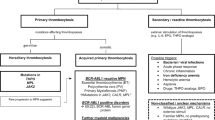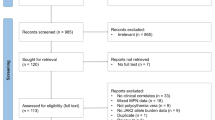Abstract
Haemophilia A (HA) is caused by a lack or reduced amount of factor VIII protein (FVIII). About one-third of patients with non-severe HA carrying specific missense mutations show discrepant results between FVIII activity (FVIII:C), measured by one-stage or chromogenic two-stage assays. The aim of this study was to elucidate the mechanism underlying the assay discrepancy in vitro and in silico. Thirteen missense mutations in the Factor 8-gene associated with discrepant results in patients were transiently expressed. FVIII:C of the mutations was determined using two one-stage assays (FVIII:C1st, FVIII:CBonn) and a two-stage chromogenic assay (FVIII:Cchr). Furthermore, thrombin generation test (TGT) and in silico analysis were performed to investigate the haemostatic potential as well as the structural impact of the variants, respectively. For the majority (9/13) of the analysed mutations, the discrepancy was confirmed. Moreover, we established a modified TGT protocol for in vitro characterization of FVIII. Hence, TGT parameters were significantly impaired in the group of variants associated with higher chromogenic values. Additionally, in silico analysis revealed the impact of the mutations on FVIII protein structure leading to assay discrepancy. Moreover, the data shows that also among one-stage clotting assays, assay discrepancy is observed. Our results show that for the majority of mutations, application of a global assay like TGT method could help to improve diagnosis or correct assessment of the severity of HA.






Similar content being viewed by others
References
Oldenburg J, Ananyeva NM, Saenko EL (2004) Molecular basis of haemophilia A. Haemophilia 10(Suppl 4):133–139. https://doi.org/10.1111/j.1365-2516.2004.01005.x
Oldenburg J, Brackmann HH, Hanfland P, Schwaab R (2000) Molecular genetics in haemophilia A. Vox Sang 78(Suppl 2):33–38
Pezeshkpoor B, Pavlova A, Oldenburg J, El-Maarri O (2014) F8 genetic analysis strategies when standard approaches fail. Hamostaseologie 34(2):167–173. https://doi.org/10.5482/HAMO-13-08-0043
de Brasi C, El-Maarri O, Perry DJ, Oldenburg J, Pezeshkpoor B, Goodeve A (2014) Genetic testing in bleeding disorders. Haemophilia 20(Suppl 4):54–58. https://doi.org/10.1111/hae.12409
Langdell RD, Wagner RH, Brinkhous KM (1953) Effect of antihemophilic factor on one-stage clotting tests; a presumptive test for hemophilia and a simple one-stage antihemophilic factor assay procedure. J Lab Clin Med 41(4):637–647
Oldenburg J, Pavlova A (2010) Discrepancy between one-stage and chromogenic factor VIII activity assay results can lead to misdiagnosis of haemophilia A phenotype. Hamostaseologie 30(4):207–211
Potgieter JJ, Damgaard M, Hillarp A (2015) One-stage vs. chromogenic assays in haemophilia A. Eur J Haematol 94 Suppl 77:38–44. https://doi.org/10.1111/ejh.12500
Biggs R (1955) Assessment of clotting efficiency. Br Med Bull 11(1):5–10
Biggs R, Eveling J, Richards G (1955) The assay of antihaemophilic-globulin activity. Br J Haematol 1(1):20–34
Barrowcliffe TW, Raut S, Sands D, Hubbard AR (2002) Coagulation and chromogenic assays of factor VIII activity: general aspects, standardization, and recommendations. Semin Thromb Hemost 28(3):247–256. https://doi.org/10.1055/s-2002-32658
Schwaab R, Oldenburg J, Kemball-Cook G, Albert T, Juhler C, Hanfland P, Ingerslev J (2000) Assay discrepancy in mild haemophilia A due to a factor VIII missense mutation (Asn694Ile) in a large Danish family. Br J Haematol 109(3):523–528
Trossaert M, Lienhart A, Nougier C, Fretigny M, Sigaud M, Meunier S, Fouassier M, Ternisien C, Negrier C, Dargaud Y (2014) Diagnosis and management challenges in patients with mild haemophilia A and discrepant FVIII measurements. Haemophilia 20(4):550–558. https://doi.org/10.1111/hae.12381
Hakeos WH, Miao H, Sirachainan N, Kemball-Cook G, Saenko EL, Kaufman RJ, Pipe SW (2002) Hemophilia A mutations within the factor VIII A2-A3 subunit interface destabilize factor VIIIa and cause one-stage/two-stage activity discrepancy. Thromb Haemost 88(5):781–787. https://doi.org/10.1267/th02110781
Mumford AD, Laffan M, O'Donnell J, McVey JH, Johnson DJ, Manning RA, Kemball-Cook G (2002) A Tyr346-->Cys substitution in the interdomain acidic region a1 of factor VIII in an individual with factor VIII:C assay discrepancy. Br J Haematol 118(2):589–594
Provaznikova D, Houskova K, Radovska A, Salaj P, Hrachovinova I (2015) Novel mutations associated with a discrepancy between one-stage and chromogenic FVIII activity assays. Haemophilia 21(4):e330–e332. https://doi.org/10.1111/hae.12705
Pavlova A, Delev D, Pezeshkpoor B, Muller J, Oldenburg J (2014) Haemophilia A mutations in patients with non-severe phenotype associated with a discrepancy between one-stage and chromogenic factor VIII activity assays. Thromb Haemost 111(5):851–861. https://doi.org/10.1160/TH13-08-0690
Pezeshkpoor B, Schreck U, Biswas A, Driesen J, Berkemeier AC, Pavlova A, Muller J, Oldenburg J (2017) An in silico and in vitro approach to elucidate the impact of residues flanking the cleavage scissile bonds of FVIII. PLoS One 12(7):e0180456. https://doi.org/10.1371/journal.pone.0180456
Hemker HC, Giesen P, Al Dieri R, Regnault V, de Smedt E, Wagenvoord R, Lecompte T, Beguin S (2003) Calibrated automated thrombin generation measurement in clotting plasma. Pathophysiol Haemost Thromb 33(1):4–15
Venkateswarlu D (2010) Structural investigation of zymogenic and activated forms of human blood coagulation factor VIII: a computational molecular dynamics study. BMC Struct Biol 10:7. https://doi.org/10.1186/1472-6807-10-7
Ngo JC, Huang M, Roth DA, Furie BC, Furie B (2008) Crystal structure of human factor VIII: implications for the formation of the factor IXa-factor VIIIa complex. Structure 16(4):597–606. https://doi.org/10.1016/j.str.2008.03.001
Shen BW, Spiegel PC, Chang CH, Huh JW, Lee JS, Kim J, Kim YH, Stoddard BL (2008) The tertiary structure and domain organization of coagulation factor VIII. Blood 111(3):1240–1247. https://doi.org/10.1182/blood-2007-08-109918
Krieger E, Vriend G (2014) YASARA view - molecular graphics for all devices - from smartphones to workstations. Bioinformatics 30(20):2981–2982. https://doi.org/10.1093/bioinformatics/btu426
Backes BJ, Harris JL, Leonetti F, Craik CS, Ellman JA (2000) Synthesis of positional-scanning libraries of fluorogenic peptide substrates to define the extended substrate specificity of plasmin and thrombin. Nat Biotechnol 18(2):187–193. https://doi.org/10.1038/72642
Petrassi HM, Williams JA, Li J, Tumanut C, Ek J, Nakai T, Masick B, Backes BJ, Harris JL (2005) A strategy to profile prime and non-prime proteolytic substrate specificity. Bioorg Med Chem Lett 15(12):3162–3166. https://doi.org/10.1016/j.bmcl.2005.04.019
Selvaraj SR, Scheller AN, Miao HZ, Kaufman RJ, Pipe SW (2012) Bioengineering of coagulation factor VIII for efficient expression through elimination of a dispensable disulfide loop. J Thromb Haemost 10(1):107–115. https://doi.org/10.1111/j.1538-7836.2011.04545.x
Kihlberg K, Strandberg K, Rosen S, Ljung R, Astermark J (2017) Discrepancies between the one-stage clotting assay and the chromogenic assay in haemophilia B. Haemophilia 23(4):620–627. https://doi.org/10.1111/hae.13219
Pemberton S, Lindley P, Zaitsev V, Card G, Tuddenham EG, Kemball-Cook G (1997) A molecular model for the triplicated A domains of human factor VIII based on the crystal structure of human ceruloplasmin. Blood 89(7):2413–2421
Keeling DM, Sukhu K, Kemball-Cook G, Waseem N, Bagnall R, Lloyd JV (1999) Diagnostic importance of the two-stage factor VIII:C assay demonstrated by a case of mild haemophilia associated with His1954-->Leu substitution in the factor VIII A3 domain. Br J Haematol 105(4):1123–1126
Pipe SW, Eickhorst AN, McKinley SH, Saenko EL, Kaufman RJ (1999) Mild hemophilia A caused by increased rate of factor VIII A2 subunit dissociation: evidence for nonproteolytic inactivation of factor VIIIa in vivo. Blood 93(1):176–183
Wakabayashi H, Griffiths AE, Fay PJ (2009) Combining mutations of charged residues at the A2 domain interface enhances factor VIII stability over single point mutations. J Thromb Haemost 7(3):438–444. https://doi.org/10.1111/j.1538-7836.2008.03256.x
Bloem E, Meems H, van den Biggelaar M, Mertens K, Meijer AB (2013) A3 domain region 1803-1818 contributes to the stability of activated factor VIII and includes a binding site for activated factor IX. J Biol Chem 288(36):26105–26111. https://doi.org/10.1074/jbc.M113.500884
Venkateswarlu D (2014) Structural insights into the interaction of blood coagulation co-factor VIIIa with factor IXa: a computational protein-protein docking and molecular dynamics refinement study. Biochem Biophys Res Commun 452(3):408–414. https://doi.org/10.1016/j.bbrc.2014.08.078
Schwaab R, Pavlova A, Albert T, Caspers M, Oldenburg J (2013) Significance of F8 missense mutations with respect to inhibitor formation. Thromb Haemost 109(3):464–470. https://doi.org/10.1160/TH12-07-0521
Makris M, Peyvandi F (2014) Assaying FVIII activity: one method is not enough, and never was. Haemophilia 20(3):301–303. https://doi.org/10.1111/hae.12446
Author information
Authors and Affiliations
Contributions
BP, JO and MG designed the study; MG and ACB performed research; BP and MG analysed the data; AB performed in silico analysis; AP and JO revised the manuscript; and BP and MG wrote the paper.
Corresponding author
Ethics declarations
Conflict of interest
The authors declare that they have no conflict of interest.
Ethical approval
All procedures performed in studies involving human participants were in accordance with the ethical standards of the institutional and/or national research committee and with the 1964 Helsinki declaration and its later amendments or comparable ethical standards.
Additional information
Publisher’s note
Springer Nature remains neutral with regard to jurisdictional claims in published maps and institutional affiliations.
Electronic supplementary material
ESM 1
(PDF 661 kb)
Rights and permissions
About this article
Cite this article
Pezeshkpoor, B., Gazorpak, M., Berkemeier, AC. et al. In silico and in vitro evaluation of the impact of mutations in non-severe haemophilia A patients on assay discrepancies. Ann Hematol 98, 1855–1865 (2019). https://doi.org/10.1007/s00277-019-03691-1
Received:
Accepted:
Published:
Issue Date:
DOI: https://doi.org/10.1007/s00277-019-03691-1




